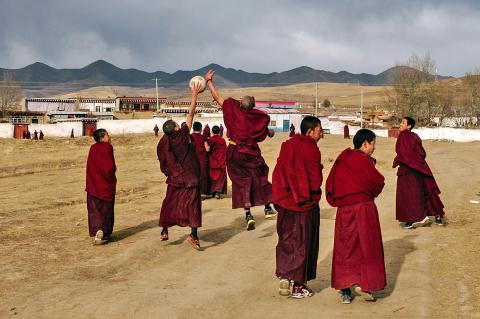Adrak’s last words before Chinese police officers dragged him away were: “May the Dalai Lama live for 10,000 years.”
The 20-year-old Tibetan monk was carrying the spiritual leader’s portrait as he walked down the main street outside his monastery, also calling for freedom for Tibet. The picture fell to the ground as police set upon him and when several onlookers joined his calls, they, too, were beaten and taken away, according to witnesses and former monks currently in exile.
However, the protest did not play out like so many previous ones — Adrak did not self-immolate, or even try to, as monks in the pasts have often done. The burnings have slowed to a trickle, replaced by less incendiary solo demonstrations after what monks say is a campaign of intimidation by the government, mainly targeting family members and friends of those who killed themselves.

Photo: AFP
Nothing has been heard of Adrak or three fellow monks since they mounted four such actions in as many days.
Their Kirti monastery in Aba has been at the center of the 143 known cases of Tibetans setting themselves on fire — most of them dying — to oppose China’s policies in the region and call for the return of the Dalai Lama, a Nobel Peace laureate.
About one-third of the total happened in Aba, in a region China claims is part of the southwestern province of Sichuan. Of those, more than half were current or former monks and nuns.
“I can choose to destroy this body for my ideas, but I can’t make a decision like that for others,” said a 24-year-old monk under the golden roof of the temple. “Many monks do not want to endanger their families.”
The town’s main road running near the temple is colloquially known as “Martyrs’ Street,” but there have been only seven self-immolations so far this year, according to rights groups.
At least 98 Tibetans have been detained, imprisoned or have disappeared because of alleged connections with someone who set themselves on fire, according to advocacy group the International Campaign for Tibet, which said the number might be much higher.
One man was condemned to death in connection with his wife’s self-immolation after authorities accused him of murdering her. Another monk was given a suspended death sentence, according to media reports — a sentence normally commuted to life in prison, for “inciting” others to burn themselves.
Observers say the model of collective punishment is not new, rather a throwback to Communist and imperial eras.
SECURITY OPERATIONS
“You create security by making other people responsible for one person’s actions,” said Robert Barnett, director of the Modern Tibetan Studies Program at Columbia University. “This threat is increasingly being used throughout China’s security operations in Tibetan areas.”
Chinese authorities keep Aba under tight control — Internet service to the region has been cut since Adrak and his fellow monks’ actions in September — and visits by international media are extremely rare, with police checkpoints on roads leading to the town.
Armed police no longer stand guard outside the Kirti Monastery’s main entrance to intimidate the 3,000 monks within, as was the norm before, while cinderblock walls hastily erected at the height of the self-immolations to ensure only one entrance and exit point have been partially dismantled.
However, a 35m-tall metal pole remains in the central courtyard, looming over every other building in the complex and festooned with floodlights and four rotating cameras, giving authorities a 360o view of the monks’ outdoor lives.
“We no longer need to set ourselves on fire to protest, now we can just protest and the government will make us disappear as if we died,” a 21-year-old monk said. “We only want equality, but we are treated like criminals.”
The monks have been forced to attend hours of political reeducation classes, but Beijing’s efforts to promote “ethnic unity” struggle to succeed.
“We are not from China,” an 11-year-old monk said in English. “We are from Tibet.”
Beijing says its troops “peacefully liberated” Tibet in 1951 and claims it has since brought economic development to a previously backward region where serfs were exploited. The government has accused the Dalai Lama of secretly backing violence in the region, while “feigning beneficence to gain international sympathy and support.”
POLITICAL AGENDAS
“Some overseas institutions try to realize their political agendas by sacrificing innocent lives,” Chinese Ministry of Foreign Affairs spokesman Hong Lei (洪磊) said. “[The self-immolations] decreasing numbers mean that their cause is a lost hope.”
Local officials did not respond to telephoned and faxed requests for comment about the September protests and the detained monks’ whereabouts.
The Dalai Lama has stayed neutral on the self-immolations, describing the burnings as acts of desperation that he is powerless to stop, and is reluctant to condemn them to avoid offending the families of the dead.
The spiritual leader fled into exile after a failed uprising in 1959, and Tibetans and overseas campaign groups say that religious and cultural freedoms are restricted, while natural resources exploitation has primarily benefited members of China’s Han majority, who have immigrated to the region en masse.
“While the Chinese government has increased the intensity of its oppression of Tibetans in Tibet, it seems that it has not been possible for them to prevent or stop Tibetans from protesting peacefully,” said Kirti Rinpoche, the abbot of the monastery, who lives in exile in India.
With fewer uniformed police on the streets, the government’s efforts to pacify the town seem to be making progress.
However, monks and locals say a climate of fear persists in Aba, and that there is heavy presence of plain-clothes police officers. Experts say those who carry out solo demonstrations are usually sentenced to between two and four years in prison.
Dissent has not been completely crushed. Five locals in Aba said some sort of protest occurs in the town “at least once every month.”
“There is so much pressure living here, no one can breathe,” said Tseda, a shop owner in Aba, who said he supported the monks’ actions. “I feel as if I have died and was reincarnated in hell.”

ECONOMIC WORRIES: The ruling PAP faces voters amid concerns that the city-state faces the possibility of a recession and job losses amid Washington’s tariffs Singapore yesterday finalized contestants for its general election on Saturday next week, with the ruling People’s Action Party (PAP) fielding 32 new candidates in the biggest refresh of the party that has ruled the city-state since independence in 1965. The move follows a pledge by Singaporean Prime Minister Lawrence Wong (黃循財), who took office last year and assumed the PAP leadership, to “bring in new blood, new ideas and new energy” to steer the country of 6 million people. His latest shake-up beats that of predecessors Lee Hsien Loong (李顯龍) and Goh Chok Tong (吳作棟), who replaced 24 and 11 politicians respectively

Archeologists in Peru on Thursday said they found the 5,000-year-old remains of a noblewoman at the sacred city of Caral, revealing the important role played by women in the oldest center of civilization in the Americas. “What has been discovered corresponds to a woman who apparently had elevated status, an elite woman,” archeologist David Palomino said. The mummy was found in Aspero, a sacred site within the city of Caral that was a garbage dump for more than 30 years until becoming an archeological site in the 1990s. Palomino said the carefully preserved remains, dating to 3,000BC, contained skin, part of the

‘WATER WARFARE’: A Pakistani official called India’s suspension of a 65-year-old treaty on the sharing of waters from the Indus River ‘a cowardly, illegal move’ Pakistan yesterday canceled visas for Indian nationals, closed its airspace for all Indian-owned or operated airlines, and suspended all trade with India, including to and from any third country. The retaliatory measures follow India’s decision to suspend visas for Pakistani nationals in the aftermath of a deadly attack by shooters in Kashmir that killed 26 people, mostly tourists. The rare attack on civilians shocked and outraged India and prompted calls for action against their country’s archenemy, Pakistan. New Delhi did not publicly produce evidence connecting the attack to its neighbor, but said it had “cross-border” links to Pakistan. Pakistan denied any connection to

Armed with 4,000 eggs and a truckload of sugar and cream, French pastry chefs on Wednesday completed a 121.8m-long strawberry cake that they have claimed is the world’s longest ever made. Youssef El Gatou brought together 20 chefs to make the 1.2 tonne masterpiece that took a week to complete and was set out on tables in an ice rink in the Paris suburb town of Argenteuil for residents to inspect. The effort overtook a 100.48m-long strawberry cake made in the Italian town of San Mauro Torinese in 2019. El Gatou’s cake also used 350kg of strawberries, 150kg of sugar and 415kg of